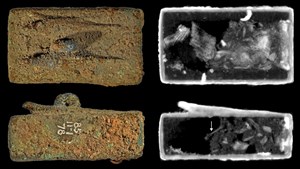
A team at the British Museum and the Science and Technology Facilities Council (STFC), part of UK Research and Innovation (UKRI), have led a pioneering study into 2500-year-old ancient Egyptian lizard mummies.
A team at the British Museum and the Science and Technology Facilities Council (STFC), part of UK Research and Innovation (UKRI), have led a pioneering study into 2500-year-old ancient Egyptian lizard mummies.
The team used an innovative technique called neutron imaging to ‘look’ inside a group of six sealed first millennium BC animal coffins from ancient Egyptian sites including Naukratis and Tell el-Yehudiyeh in the Nile Delta.
Neutron imaging is more effective than X-ray imaging at seeing through metal. It allowed the researchers to ‘unwrap’ the mummies and see organic remains through their bronze or leaded copper alloy containers. It has huge potential as a tool to help archaeologists analyse complex objects without causing any damage to them.
The imaging confirmed that the coffins contained bones likely to be North African wall lizards which had been wrapped in textile - probably linen. Linen was widely used in the Egyptian mummification practices for animals as well as humans.
Animal mummification was common in ancient Egypt – with some cases of people mummifying their pets to ensure their presence with them in the afterlife. The lizards placed in these coffins were not pets but mummified as part of religious practices and beliefs that thrived particularly in the first millennium BC.
They are believed to have been linked with the cult of Egyptian creator and sun gods, such as Atum who was often depicted as a human-headed creature with a part-cobra part-eel body, as seen on two coffins the team analysed.
Some mummified animals, like bulls, were selected during their life by priests because they were believed to be the physical incarnations of Egyptian gods. These animals would then live in a sanctuary dedicated to the god until their natural death. However, most mummified animals, like most cats and ibises, were bred in large numbers and sometimes killed young. They probably represented sacred offerings or were perhaps mummified at religious festivals. This may have been the case for the lizards that were studied here.
Animals associated with specific Egyptian deities mummified after their death were sometimes buried in dedicated labyrinthine buildings. It is estimated that some of these underground complexes counted hundreds of thousands of animal mummies.
Three of the coffins studied were uncovered in Naukratis, in a cache in which many sacred objects including over one hundred animal coffins mostly topped with figures of lizards, eels and snakes were discovered. A 3rd-century BC inscription tells us that a snake form of the god Amun-Ra was revered in the cosmopolitan port, and it may be to him that these animals were dedicated.
Only a proportion of the huge numbers of animals that ended up mummified were then placed in metal containers in the form either of a statue or a coffin topped by a representation of an animal. The reason for this could be that the containers were quite expensive to make and required expertise in their manufacture. Or it could also be linked with the way the containers were used or displayed. Some of the animal coffins had one or more loops welded on their surface suggesting they could have been hung, probably for religious purposes.
The imaging was conducted at the STFC ISIS Neutron and Muon Source, located at the STFC Harwell Campus in Oxfordshire, the UK’s leading centre for neutron and muon research.
The study, “Neutron tomography of sealed copper alloy animal coffins from ancient Egypt”, is being published in Scientific Reports on 20 April.
Dr Daniel O’Flynn, X-ray Imaging Scientist at the British Museum: “By utilising the capabilities of neutron imaging we were able to study the sealed animal coffins non-invasively and further our knowledge on the fascinating world of animal mummification in ancient Egypt.”
Dr Aurélia Masson-Berghoff, Project Curator at the British Museum: “In the first millennium BC, lizards were commonly mummified in ancient Egypt, as were other reptiles, cats, dogs, falcons, ibises, shrews, fishes... Lizards, like snakes and eels, were particularly associated with ancient Egyptian solar and creator gods such as Atum and perhaps, in the case of Naukratis, with Amun-Ra Shena. With the help of neutron imaging, we have the potential to learn more about the ritual and votive practices surrounding these once impenetrable animal coffins, the ways they were made, used and displayed.”
Dr Anna Fedrigo, Marie Skłodowska-Curie Fellow at STFC: “Neutron imaging has many important applications in 21st-century science. This study shows that it can also shed light on the inner structure of complex archaeological objects, including their manufacturing techniques and contents.”
Prof Roger Eccleston, Director, STFC ISIS Neutron and Muon Source: “This is fascinating work, using neutron imaging to look inside sealed copper alloy animal containers and to study the manufacturing process without damaging the artefact. This work demonstrates the power of neutron imaging and the way it complements X- ray tomography in such studies.”
Image : Animal coffin with a loop EA27584, surmounted by two lizard figures (top and side view). Neutron imaging shows textile wrappings and an 8mm long bone (arrow); from the port of Naukratis in the western Nile Delta.

ArtDependence Magazine is an international magazine covering all spheres of contemporary art, as well as modern and classical art.
ArtDependence features the latest art news, highlighting interviews with today’s most influential artists, galleries, curators, collectors, fair directors and individuals at the axis of the arts.
The magazine also covers series of articles and reviews on critical art events, new publications and other foremost happenings in the art world.
If you would like to submit events or editorial content to ArtDependence Magazine, please feel free to reach the magazine via the contact page.